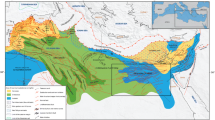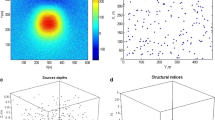Abstract
The hidden objects are located, as sixteen objects (anomalies) on the reduction to magnetic pole data (RTP). The follow-up and identification of these objects by applying several digital filters, as upwarding continuation at different level, then the horizontal derivative (HD) and vertical derivative (VD). Accordingly, the edge detection filter techniques are dependent on the tilt derivative (horizontal, vertical derivatives) and the tilt angle. This study shows closing to the basic dykes (shallow anomalies) that imprinted in the RTP map and the upward continuation maps at shallow levels. The residual features are mostly starting to disappear gradually in the upward continuation maps at intermediate and deeper levels. The last upwarding maps illustrate the penetrated roots of these bodies to deep levels (deep anomalies). The advanced filter technique of edge detection is the enhanced total horizontal derivative of the tilt angle (ETHDR). This study delineates and compares the hidden objects by applying the different filter techniques, as the analytical signal (AS), first vertical derivative (FVD), total horizontal derivative (THDR), tilt angle (TA), horizontal tilt angle (TDX), and ETHDR. The applied derivative-based filters, as ETHDR, produce more detailed results for the shallower and deeper magnetized structures. The compared filter results such as TA, TDX, and ETHDR give sharp edges of the magnetized sources (hidden objects). Quantitatively, the determined depths have been evaluated, using the 2D modeling algorithm. The depths and relief of the basement surface across eight profiles are defined, and the depths and shapes of the hidden objects are outlined. Meanwhile, magnetic susceptibility contrasts of the hidden objects are varied with different expanding shapes and subsurface depths.









Similar content being viewed by others
References
Abdelrahman EM, Abo-Ezz ER, Essa KS, El-Araby TM, Soliman KS (2007) A new least-squares minimization approach to depth and shape determination from magnetic data. Geophys Prospect 55:433–446
Abdelrahman EM, Abo-Ezz ER, Essa KS (2012) Parametric inversion of residual magnetic anomalies due to simple geometric bodies. Explor Geophys 43:178–189
Abo-Ezz ER, Essa KS (2016) A least-squares minimization approach for model parameters estimate by using a new magnetic anomaly formula. Pure Appl Geophys 173:1265–1278
Aero-Service (1984) The Egyptian general petroleum corporation. Final operational report of airborne magnetic/radiation survey in the Eastern Desert, Egypt for the Egyptian General Petroleum Corporation. Aero-Service, Houston, Texas, 6, April, 250 p
Arisoy MZ, Dikmen U (2013) Edge detection of magnetic sources using enhanced Total horizontal derivative of the tilt. Bulletin of the Earth Sciences Application and Research Centre of Hacettepe University, Yerbilimleri 3(4):73–82
Asadi H, Hale M (2001) A predictive GIS model for mapping potential gold and base metal mineralization in Takab area, Iran. Comput Geosci 27(8):901–912
Baranov V (1957) A new method for interpretation of aeromagnetic maps, Pseudogravimetric anomalies. Geophysics 22:359–383
Baranov V (1975) Potential field data and their transformation in applied geophysics. Geoexploration Monograph; Series 1–6, Gebruder Borntaeger, Berlin– Stuttgart, Germany
Baranov V, Naudy H (1964) Numerical calculation of the formula of reduction to the magnetic pole. Geophysics 29:67–79
Bhattacharyya K (1965) Two–dimensional harmonic analysis as a tool for magnetic interpretation. Geophysics 30:829–857
Bhattacharyya K (1967) Reduction filters for digital processing of potential field data. Geophysics 31:712–726
Billings D, Newsam N (2002) Fourier filtering of continuous global surfaces. IEEE, Digital Signal Processing, 14th International Conference, Cat. No.02TH8628
Clark DA, Emerson DW (1991) Notes on rock magnetization characteristics in applied geophysical studies. Explor Geophys 22:547–555
Clarke KG (1969) Optimum second-derivative and downward continuation filters. Geophysics 34:424–437
Cooper GJ (2009) Balancing images of potential-field data. Geophysics 74(3):L17–L20
Cooper GJ, Cowan DR (2006) Enhancing potential field data using filters based on the local phase. Comput Geosci 32(10):1585–1591
Cooper GJ, Cowan DR (2008) Edge enhancement of potential-field data using normalized statistics. Geophysics 73(3):H1–H4
Cordell L, Grauch VJS (1985) Mapping basement magnetization zones from aeromagnetic data in the San Juan basin, New Mexico. In: Hinzc WJ (ed) The utility of regional gravity and magnetic anomaly maps, Soc. Expl. Geophys, pp 181–197
Deng Y, Chen Y, Wang P, Essa KS, Xub T, Liang X, Badal J (2016) Magmatic underplating beneath the Emeishan large igneous province (South China) revealed by the COMGRA-ELIP experiment. Tectonophysics 672-673:16–23
EGSMA (2009) Geologic map of Wadi Al Barramiyah, Central Eastern Desert 1: 250,000, 2009
El khodary ST, Youssef MAS (2013) Integrated potential field study on the subsurface structural characterization of the area north Bahariya oasis, Western Desert, Egypt. Arab J Geosci 6(9):3185–3200
El Sirafe AM (1986) Application of aeromagnetic, aeroradiometric and gravimetric survey data in the interpretation of the geology of Cairo Bahariya area, north western desert, Egypt. Ph. D. Thesis, Ain Shams Univ
Essa KS, Elhussein M (2017) A new approach for the interpretation of magnetic data by a 2-D dipping dike. J Appl Geophys 136:431–443
Essa KS, Elhussein M (2019) Magnetic interpretation utilizing a new inverse algorithm for assessing the parameters of buried inclined dike-like geologic structure. Acta Geophys 67:533–544
Essa KS, Nady AG, Mostafa MS, Elhussein M (2018) Implementation of potential field data to depict the structural lineaments of the Sinai peninsula, Egypt. J Afr Earth Sci 147:43–53
Jacobsen HB (1987) A case for Upwarding continuation as a standard separation filter for potential field maps. Geophysics 52:1138–1148
Juneja M, Sandhu P (2009) Performance evaluation of edge detection techniques for images in spatial domain. Int J Comput Theory Eng 1(5):1793–8201
Karimi K, Shirzaditabar F (2017) Using the ratio of the magnetic field to the analytic signal of the magnetic gradient tensor in determining the position of simple shaped magnetic anomalies. J Geophys Eng 14:769–779
Marson I, Klingele EE (1993) Advantages of using the vertical gradient of gravity for 3-D interpretation. Geophysics 58:1588–1595
Mehanee SA, Essa KS (2015) 2.5D regularized inversion for the interpretation of residual gravity data by a dipping thin sheet: numerical examples and case studies with an insight on sensitivity and non-uniqueness. Earth Planets Space 67:130
Mehanee S, Essa KS, Smith P (2011) A rapid technique for estimating the depth and width of a two-dimensional plate from self-potential data. J Geophys Eng 8:447–456
Mekonnen TK (2004) Interpretation and Geodatabase of Dukes using Aeromagnetic data of Zimbabwe and Mozambique. M. Sc. Thesis, International Institute for Geoinformation science and Earth Observation, Enschede, the Netherlands. Retrieved from http://www.slideserve.com/phila/partner
Miller HG, Singh V (1994) Potential field tilt a new concept for location of potential filed sources. J Appl Geophys 32:213–217
Nigm AA, El khodary ST, Elgendi NH, Abdelwahab FM (2015) Mapping the subsurface structural features of Al-Laqitah area, central Eastern Desert of Egypt using aeromagnetic data. Arab J. Geoscience 8:3537–3549
Oasis Montaj package V.7.1 (2010) Geosoft mapping and processing system. Johannesburg, p 17
Oliveiraa S, Ferreirab F, Souzac J (2017) Edge detect PFI: an algorithm for automatic edge detection in potential field anomaly images – application to dike-like magnetic structures. Comput Geosci 103:80–91
Pawlowski RS (1995) Preferential continuation for potential field anomaly enhancement. Geophysics 60:390–398
Pilkington M, Keating P (2004) Contact mapping from gridded magnetic data –a comparison of techniques. Explor Geophys 35:206–311
Wijns CCP, Kowalczyk P (2005) Theta map: edge detection in magnetic data. Geophysics 70:L39–L43
Wong BY, Laughlin DE (1998) Determination of basic magnetic unit size in CoCrTa/Cr magnetic disk media. IEEE Trans Magn 34(1):293–298
Yaoguo L, Sarah GR, Devriese A (2013) Enhancement of magnetic data by stable downward continuation for UXO application. IEEE Trans Geosci Remote Sens Soc 51(6):3605–3614
Acknowledgments
Authors would like to thank Prof. L. Wong and Prof. R. Ulusay, co-editor-in-chief, and the two anonymous expert reviewers for their keen interest and constructive comments for improving this manuscript.
Author information
Authors and Affiliations
Corresponding author
Rights and permissions
About this article
Cite this article
Fkirin, M.A., Youssef, M.A.S. & El-Deery, M.F. Digital filters applications on aeromagnetic data for identification of hidden objects. Bull Eng Geol Environ 80, 2845–2858 (2021). https://doi.org/10.1007/s10064-020-02067-4
Received:
Accepted:
Published:
Issue Date:
DOI: https://doi.org/10.1007/s10064-020-02067-4




